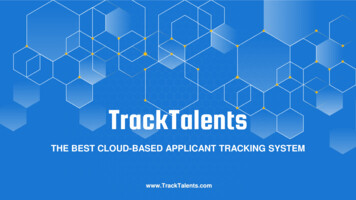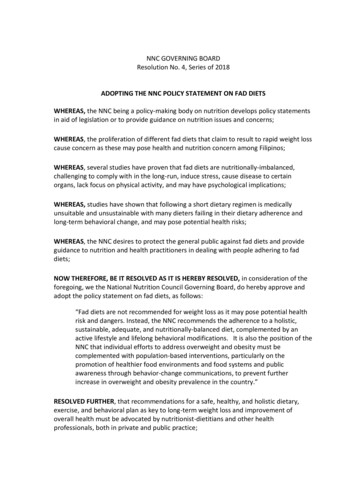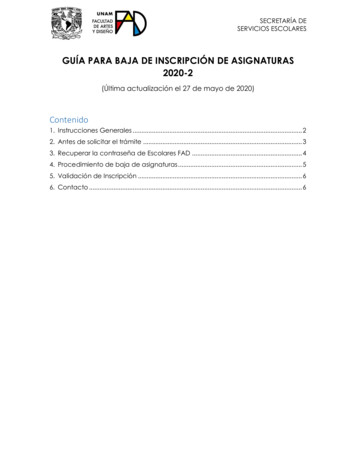
Transcription
AI Resume Parser:Fad or Fact?An Insight into the working of ML-based Resume Parsing Technology
Recruiters have been screening resumes manually for a long time now.They read through every candidate resume and evaluate them on thebasis of skills, knowledge, abilities and otherdesired factors.However, it would take a long time for the recruiter to go through eachresume in detail. So, in practical world recruiters are forced into doingone of the two things:They go through limited resumes, scan them thoroughly and take apick out of them.They go through all (or most) of them, take a minimal amount of timeto review them(some claim as low as 6 seconds), and pick whicheverresumes can hook them.In both the cases, organizations lose out on quality candidates andrecruiters waste their time and effort.So, How can one avoid it?This is where resume parsers come into the picture.What is resume parsing?Resume Parsing, formally speaking, is the conversion of a free-formCV/resume document into structured information - suitable forstorage, reporting, and manipulation by a computer.Resume parsers analyze a resume, extract the desired information, andinsert the information into a database with a unique entry for eachcandidate. Once the resume has been analyzed, a recruiter can searchthe database for keywords and phrases and get a list of relevantcandidates.
So why is resume parsing so difficult?Almost everyone tries to use a unique template to put information ontheir CV, in order to stand out. For a human, reading these CVs or a jobad is an easy task. These semi-structured documents are usuallyseparated into sections and have layouts that make it easy to quicklyidentify important information.In contrast, for a computer, the task of extracting information becomesdifficult with every change of format. Generally speaking here are thefew kinds of resume parser available in the market:010203Key-word based resume parser: A keyword-based resumeparser works by identifying words, phrases, and simple patternsin the text of the CV/Resume and then applying simple heuristicalgorithms to the text they find around these wordsGrammar based resume parser: The Grammar-based resumeparsers contain an enormous number of grammatical rules thatseek to understand the context of every word in the CV/resume.These same grammars also combine words and phrases togetherto make complex structures that capture the meaning of everysentence in the resume.Statistical Parsers: This type of parser attempts to applynumerical models of text to identify structure in a CV/Resume. Likegrammar-based parsers, they can distinguish between differentcontexts of the same word or phrase and can also capture a widevariety of structures such as addresses, timelines, etc.
Without diving deep into the benefits and limitations of each of them,let us talk about the bottom line - accuracy. Most resume parsers useany of the above technologies to provide close to 60% accurate resultsin real-world scenarios. However, when compared with humanaccuracy of 96%, they are definitely lagging behind.10096%8060%6040200Human AccuracyResume parser accuracy withKeyword/ Grammer based orStatistical Parser techinqueThere are many ways to write dates and numerous job titles and skillsappear every month. Someone’s name can be a company name (e.g.Harvey Nash) or even an IT skill (e.g. Cassandra). The only way a CVparser can deal with this is to “understand” the context in whichwords occur and the relationship between them.That is why a rule-based parser will quickly run into two big limitations:The rules will get quite complex to account for exceptions andambiguityThe coverage will be limited.
So what’s the solution?ML-based Resume ParsingThe problem of Resume Parsing can be broken into two majorsubproblems - Text Extraction, and Information Extraction. A state ofthe art resume parser needs to solve both these problems with thehighest possible accuracy.01 Text ExtractionAlmost everyone tries to use a unique template to putinformation on their CV. Even the templates that might seemindistinguishable to the human eye, are processed differentlyby the computer.This creates the possibility of hundreds of thousands oftemplates in which resume are written worldwide. Not alltemplates are straightforward to read. For eg. One can findtables, graphics, columns in a resume, and every such entityneeds to be read in a different manner. Therefore it is easy toconclude that rule-based parsers do not stand a chance andan intelligent algorithm is required to extract text in ameaningful manner from raw documents (pdf, doc, docx, etc).
SolutionAny parser that aims to become a state-of-the-art technology in itsniche needs to explore several libraries- pdf, doc, docx, etc. However, asingle type of algorithm is not good enough to extract all thesedocument formats.A new classification system that segregates the resumes into differenttypes, based on their template, and tackles each type differently, is theway forward. Some of the types are straightforward, but most of them(like the ones that contain tables, partitions, etc) require higher-orderintelligence from the software.For such complex types, Optical Character Recognition (OCR) alongwith Deep NLP algorithms on top can help in extracting the requiredtext. For every problem, there is a hard way and a smart way. OCR is avery generic problem which has been researched upon and solved bythe biggest tech companies in the world. Most of the technology is opensource as well! Therefore, rather than building a deep learning modelfrom scratch for OCR and NLP, the smart way was to use the power ofopen source and deploy an off the shelf model for the task.With the help of classification algorithms to segregate the resumes,some modern players have been able to amalgamate differenttechnologies and obtain the best of all, to build highly accurate and fasttext extraction methods.
02Information ExtractionA typical resume can be considered as a collection ofinformation related to - Experience, Educational Background,Skills, and Personal Details of a person. These details can bepresent in various ways, or not present at all.Keeping up with the vocabulary used in resumes is a bigchallenge. A resume consists of company names, institutions,degrees, etc. which can be written in several ways. For eg.Skillate:: Skillate.com - Both these words refer to the samecompany but will be treated as different words by a machine.Moreover, every day new companies and institute names comeup, and thus it is almost impossible to keep the software’svocabulary updated.Consider the following two statements:1. ‘Currently working as a Data Scientist at Amazon Skillate’And,2. ‘Worked in a project for the client Amazon ’In the first statement, “Amazon” will be tagged as a company asthe statement is about working in the organization.But the latter “Amazon” should be considered as a normal wordand not as a company. It is evident that the same word can havedifferent meanings, based on its usage.
SolutionThe above challenges make it clear that statistical methods like NaiveBayes are bound to fail here, as they are severely handicapped by theirvocabulary and fail to account for different meanings of words. So canthis seemingly hard problem be cracked? Deep Learning can do all thehard work for us! This approach is called Deep Information Extraction.A thorough analysis of the challenges posed makes it evident that theroot of the problem here is understanding the context of a word.Consider the following statement‘2000–2008: Professor at Universitatea de Stat din Moldova’It is quite likely that you wouldn’t have understood the meaning of allthe words in the above statement, but even if you don’t understand theexact meaning of these words, you can probably guess that since“professor” is a job title, “Universitatea de Stat din Moldova” is mostlikely the name of an organization. Now consider one more example,with two statements:‘2000–2008: Professor at IIT Kanpur’‘B.Tech in Computer Science from IIT Kanpur’Here, IIT Kanpur should be treated as an Employer Organisation in theformer statement and as an Educational Institution in the later. We candifferentiate between the two meanings of ‘IIT Kanpur’ here byobserving the context. The first statement has ‘Professor’ which is a JobTitle, indicating that IIT Kanpur be treated as a ProfessionalOrganisation. The second one has a degree and major mentioned, whichpoint towards IIT Kanpur being tagged as an Educational Organisation.
Applying Deep Learning to solve Information Extraction greatly helpedus to effectively model the context of every word in a resume.To be specific, Named Entity Recognition (NER) is the algorithm thatdeep learning can be applied to, for information extraction in resumes.“NER is a subtask of information extraction that seeks to locate andclassify named entity mentions in unstructured text into predefinedcategories such as the person names, organizations, locations, etc,based on context.”Through the examples mentioned above, it should be clear that NER is avery domain-specific problem, and thus it is required to build a deeplearning model from scratch.
Building the deep learning modelFor building a model from scratch, the first step is to decide the modelarchitecture. Research papers and other literature on NLP indicateusing LSTMs (a type of Neural Network) in the model, as it takes intoaccount the context of a word in a statement. Once the entirearchitecture is agreed upon, one needs to start working on curating adataset for model training and evaluation. This step is the mostcumbersome process and needs to be thought out from a very earlystage.One of the most important things to consider is the data on which thesystem is being trained. The data needs to be unlabelled and should notcause more ambiguity. Online tools that can help in collaborating themanual annotation efforts within the team are also of big help.Small POCs on shorter datasets should be the early path to success.Once the results start to show up, data labeling and further training ofthe system can provide the desired results.The task of data labeling is often considered trivial and lowly, however,it actually gives an insight into the performance of the model which isnot possible with any research paper. Below is a snippet from the NERmodel results. It shows how the model is able to recognize anddifferentiate the different meanings of the phrase ‘IIT Kanpur’ indifferent contexts. Each word has a corresponding label.TIT - Designation, COM - Professional Organization, INS - Educational Institute, DEG - Degree, OTH - Other
Benefits of AI-based resume parsing.docProcesses various file formats: The AI-based resume parsercan process all popular file types including PDF, DOC, DOCX,ZIP, giving candidates the freedom to upload their resume inany format.Deciphers complex resumes: The AI-based parser recognizesand extracts information from divergent formats. Example:Tabular templates, image scanning, etc.Machine learning for better accuracy: Optical CharacterRecognition (OCR) and Deep NLP algorithms to extract text fromresumes.Lightning-fast processing: The AI-enabled parser takes 1-3seconds to process the most complex of the resumes.Resume Quality Score: Indexes resume based on theirpedigree with AI-backed score, irrespective of the job profile.
About Skillate AI resume parserSkillate is an advanced decision-making engine to make hiring easy,fast, and transparent. The product helps in optimizing the entire valuechain of recruitment, beginning from creating the job requisition, toresume matching, to candidate engagement.“The Skillate Resume Parser uses Deep Learning toextract information from the most complex resumes.The AI-enabled parser takes 1-3 seconds to processthe most complex of the resumes. Deep Learningapplied to Named Entity Recognition (NER) for 93%accurate information extraction.”
AI Recruitment platformSkillate is an advanced decision-making engineto make hiring easy, fast and transparent.India Office#2751, Ground Floor, 31st Main Rd,1st Sector, HSR Layout, Bengaluru,Karnataka, 560102 91 70223 08814contact@skillate.comUS Office1160 Battery Street East, Suites 100,San Francisco, California, USA 94111 1 415 918 6004contact@skillate.com
What is resume parsing? Resume Parsing, formally speaking, is the conversion of a free-form CV/resume document into structured information - suitable for storage, reporting, and manipulation by a computer. Resume parsers analyze a resume, extract the desired information, and insert the information into a database with a unique entry for each










